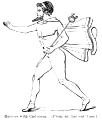Caduceus
(
κηρύκειον). The staff or mace carried by Greek ambassadors
and heralds in time of war (
Herod.ix. 100;
Thuc.i. 53). The name is often given to the staff or wand with which Hermes, or
Mercury, is conventionally represented.
 |
|
Hermes with Caduceus. (From an Ancient Vase.)
|
The caduceus was originally only an olive-branch with garlands, which were
afterwards formed into snakes. About these snakes, later mythologists like Hyginus invented
various stories—that Hermes once found two snakes fighting, and divided them with
his wand; from which circumstance they were used as an emblem of peace.
From caduceus was formed the word
caduceator, which signified a person
sent to treat of peace. Thus Aulus Gellius tells us that Q. Fabius sent to the Carthaginians a
spear and a caduceus as the emblems of war or peace (
hastam et caduceum, signa
duo belli aut pacis). The persons of the
caduceatores were
considered sacred.
It would appear, however, that the Roman ambassadors did not usually carry the caduceus,
since Marcian informs us that they carried vervain (
sagmina), so that no
one might injure them, in the same manner as the Greek ambassadors carried the
κηρύκεια. The illustration given above is from Millin's
Peintures de Vases Antiques.





